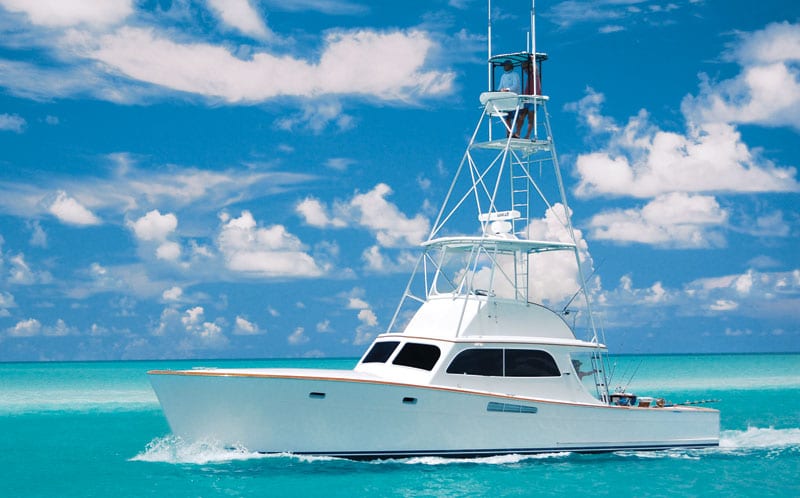
Fishing Abroad
If your idea of a dream vacation centers around fishing in a foreign country from your own boat, the next couple of months provide the perfect opportunity for travel, with generally stable weather and hungry fish. And with the dependability and range of today’s boats, along with satellite navigation and communications, the prospect of running long distances isn’t as overwhelming as it used to be. Still, a trip of this nature requires careful planning and preparation.
“One of the biggest mistakes people make is not doing a good shakedown run beforehand,” says Tom Twyford, executive director of Florida’s West Palm Beach Fishing Club and a Bahamas cruiser for the last two decades. “I always urge members to run the boat first with a trip-like load in real sea conditions. With extra crew, gear, bait, ice and fuel, a boat runs differently than under a normal load. A preliminary trip gives a good assessment of how it will handle during the crossing.”
When making Bahamas runs, club members are encouraged to pair up with boats of comparable speed and performance. It’s 53 miles from Lake Worth Inlet, Florida, to West End, Grand Bahama Island, or 1 hour 45 minutes from Miami Beach to Bimini, Bahamas, under normal conditions in a midsize center console.
Twyford strongly advocates safety and believes in wearing automatic inflatable life jackets while under way. He also carries a waterproof ditch bag with extra flares, a handheld VHF radio, a cell phone, foul-weather gear, a waterproof flashlight, water, crackers and a signal mirror. “My ditch bag has everything I’d need if I find myself in the water unexpectedly,” he explains. “A small mirror is especially important. A flash from it can be seen a long distance if you’re a little speck in a big ocean.”
Filing a float plan is another important aspect of long-distance cruising, as is keeping others apprised. “A float plan with no clearance at the other end is worse than no news at all,” says Capt. Bouncer Smith of Miami, another frequent Bahamas visitor. “Let ’em know when you get to your destination.”
Even with the many tools now available to gauge the weather, always plan for the unexpected. It can be fairly calm close to shore yet rough in the middle of the Gulf Stream. During my last Bahamas crossing in a Jupiter 38, we encountered 8-footers halfway across. We slowed down and made it without any trouble. When we came back, the seas were slick and we ran 40 miles per hour. When planning a trip, always factor in a couple of extra days in case the weather turns nasty and you’re stuck at the marina. “Avoid crossing when you have strong winds out of the northwest quadrant,” Smith explains. “Otherwise you’ll have 2-footers off the beach to start and 10-footers in the Gulf Stream.”
Smith and Twyford both recommend having the boat serviced before a trip and carrying spare parts. Items like spark plugs, a propeller and kit (with a prop wrench and set of washers and cotter pins), oil, and a fuel/water separator filter are cheaper and easier to find stateside. Underground fuel-storage tanks are common in the Bahamas, so filters are vital in case of contamination or ethanol issues. Twyford also says it’s prudent to verify the type of fuel before filling to make sure you’re getting gas instead of diesel or vice versa.
Mexico is another popular fishing destination for cruising American anglers. Dozens of boats make the run from south Florida, the Carolinas and Gulf states every spring for the Yucatan sailfish and marlin season. From the West Coast, Cabo San Lucas and points beyond are favorite stopovers. Capt. Sammy Talbert, skipper of Sneak Attack, a 65-foot American Custom Yacht, has fished Mexico since 1989.
“The trip from San Diego to Cabo is about 730 nautical miles,” he says. “There are two places to stop for fuel if it’s needed — Ensenada, just a few hours down the coast, and the famous Turtle Bay, which is about halfway. Turtle almost always has fuel, but it is pricey. On my boat, I hold more than 1,800 gallons, and at 8.2 knots, I am only burning 10 gallons per hour. So even calculating the generator consumption, I only need about 1,000 gallons to make the trip nonstop. The run from Key West, Florida, to Cancun or Isla Mujeres, Mexico, is 385 miles, and most modern sport-fishers can make it in one day if the weather is nice by running at 30 knots, if you don’t mind burning the fuel.”
Besides planning for mechanical and navigational considerations, make sure you have all the required documentation, including passports and fishing and boating permits. Don’t fish until you clear customs and know the local fishing regulations, as well as what you can and can’t bring back home.
“Always remember you’re a guest in a foreign country,” Twyford advises. “Be patient and courteous, and enjoy the pace. Take extra money along for tipping, and hire a local guide to show you around the first time. He’ll definitely appreciate it, and you’ll gain local knowledge quicker.”









